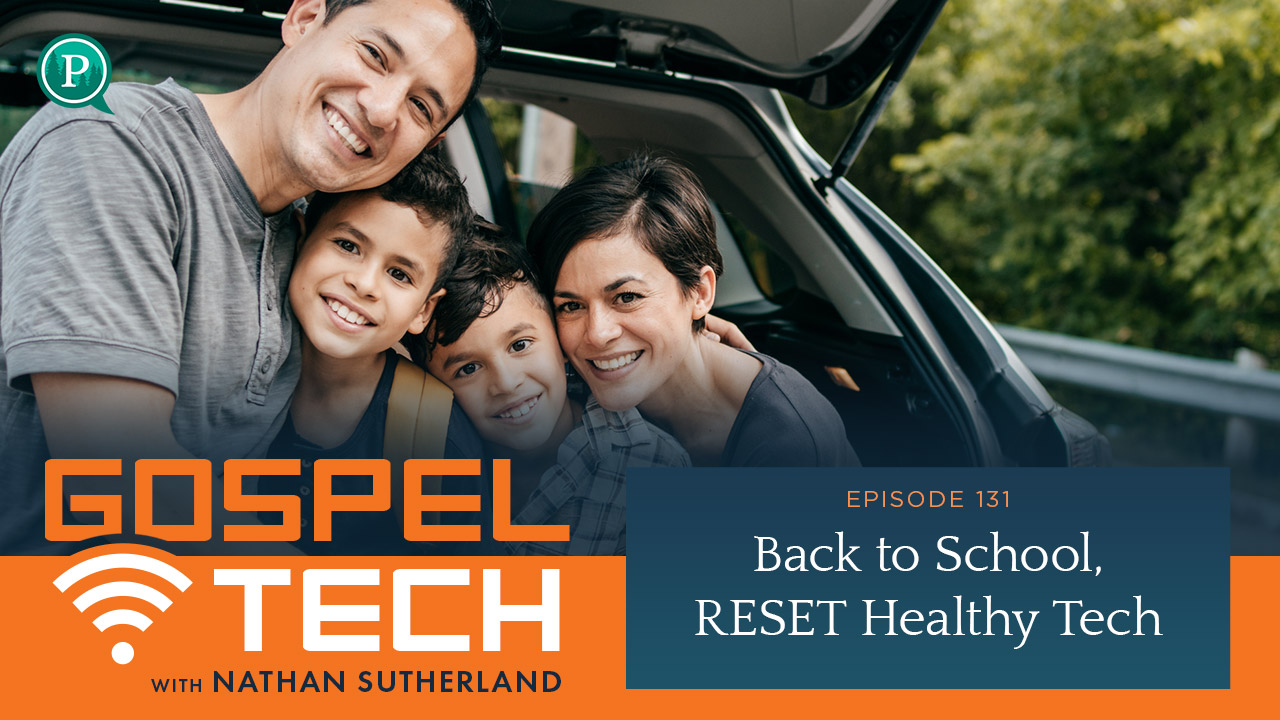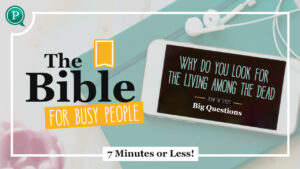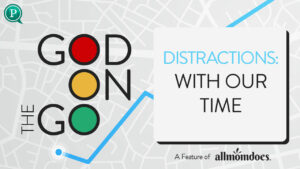How do we prep our tech for school? We use a RESET.
In today’s conversation we’ll discuss the two types of tech, how to assess tech health, and some practical ways we can begin these conversations at home with children of all ages.
Show Links:
Gospel Tech
Transcription:
Purposely. Your life. God’s purpose. Listen at onpurposely.com.
Hello everyone. And welcome to the Gospel Tech podcast. My name is Nathan Sutherland, and this podcast is dedicated to helping families love God and use tech. We are kicking off today, our back-to-school series. We have a number of episodes planned so that we can have this conversation about what does it look like to love God, to use tech, and to do that practically in the season of returning back to school.
In fact, we have seven episodes planned where we will talk through, well today, we’re going to talk about how do we reset our tech expectations, and then we’ll go through everything from how do we make tech safe at home, to understanding social media, smartphones, video games, all that stuff, and do it in context to returning back to school.
So, today’s conversation we’re going to talk though tool tech, drool tech, and reset. And at the end of the conversation, you are going to be able to understand these ideas and have some practical ways you can apply them with your own family, in the context of heading back to school and looking at what does this look like for us to love God and use tech.
So, with no further ado, let’s get this conversation started.
Welcome to the Gospel Tech podcast. A resource for parents who feel overwhelmed and outpaced as they raise healthy youth in a tech world. As an educator, parent, and tech user, I want to equip parents with the tools, resources, and confidence they need to raise kids who love God and use tech.
So, how do we reset our technology for the school year? Well, the first thing we’ve gotta figure out is does our tech need to be reset? So, let’s talk first about what we mean when we say technology. Technology, there’s actually two types. You have tool tech, and you have drool tech. Tool tech is tech that helps you create. It is driven by you.
You have a goal; you’re going to make something that’s coming outta your brain. That big, beautiful brain God’s given you. It’s using your gifts, your talents, your abilities, and it is going to be made using this technological medium. So, maybe you’re typing into word processor. Maybe you’re creating a video, or even a video game.
Maybe you’re making music or you’re sewing something, or whatever it is, you’re engaging technology, and it is doing what you tell it to do. It can’t move faster than the pace of your brain, because you are the one running it. And if you leave, it quits doing the thing it’s doing, right. So, my word processor quits typing when I walk away. This podcast quits recording when I walk away. It is, it is tool tech. It’s simply leveraging my ability, and it helps me do it better. That’s really powerful. Really cool. And it’s important for us to remember that there is that kind of technology, cuz there’s also another kind of technology we call drool tech.
Drool tech helps us consume. This doesn’t mean it’s bad. It does mean it’s designed differently, and we interact with it differently. When we consume technology, it means that I’m passive in the process, and it also means that it’s really easy to get over stimulated. I can consume multiple types of drool tech at once. I can listen to music while I watch a show. While I right, am whatever, engaging in a, in a third variety on social media, something like that. But drool tech, because I’m passive in the process, I can now be over stimulated, and it often is built differently. Whereas tool tech is built to help me accomplish my own goal. Most drool tech has a goal for me. It usually involves wanting to take more of my time, more of my focus, and more of my money.
So, here’s what I mean by that more time; drool tech wants to keep you in one sitting as long as possible. So, we’ll use YouTube for example. When you go to YouTube yes, it can be incredibly useful to go to YouTube and learn how to, for example, I fixed my air conditioning unit by learning how to replace a part. Right. Very useful. But YouTube isn’t happy just helping me fix my AC unit. It wants to keep me on AC unit videos as long as possible. Right. So, it wants to keep my time because I’m worth money when I’m on there longer. But let’s say I leave. Well, then they want me to come back more often than I want. And that’s where the focus comes in. So, if my time is my single sitting, but if it can only keep me for two minutes, it wants me to come back for two minutes twice, rather than just once. Or maybe two minutes, three times. So, it wants me to come back frequently. And then the final one is it wants my money. Either it wants me to purchase things because that’s good for business, or it wants me to be worth more money, which comes back to the time and the focus. So, drool tech tends to have a goal for us other than purely the goal that we showed up. I want to have fun. I want to enjoy this. I want to, you know, just relax and not think about something. That’s our goal, going into most drool tech. Drool tech usually has a secondary goal for us, and it spends most of its time trying to convince us that those are better goals than whatever we wanted to do.
This is when Netflix just scrolls the next video for you, right. And it just starts without you actually clicking on it because you were going to stop and go to bed. And Netflix decided, you know, what you probably want to do? Watch the next episode. And that’s really important is we talk tool tech and drool tech. We want to keep it in mind that drool tech has another goal. How do you know then if it’s drool tech? Here’s some key factors. If your technology has one or more of these, it’s at least partly drool tech. If it has notifications, meaning you weren’t thinking about it and it reminded you that it exist. That’s probably drool tech.
If it has followers and likes or likes, I guess one or the other, probably drool tech. It’s, it’s getting buy-in through the social pressure and the desire we all have to be to, to belong and to be known. If there’s a feed page… that means there’s a bunch of information for you to check out that you didn’t ask for, it’s just being compiled based on your user preferences or on your search history. If it has infinite scroll, there is no bottom to it, it just keeps populating more info. If you can pull down on the screen and it gives you that little swirly circle and then pops up new information each time, it’s probably drool tech.
If there are points, levels, rewards, it’s drool tech. So, let’s do a little comparison using those characteristics of drool tech against tool tech. There are really four types of drool tech. You have shows, so any kinda streaming service, video games, social media, and streaming music. So, we have those categories. Now let’s compare that to some kind of tool tech and it looks a little bit like this. Let’s say you have Microsoft word, or Mac pages, and you are writing in that. You click save and you close it. At no point, does that technology reach out to you and say, Hey, did you remember that you were writing that really good story? Have you thought about writing it again? Right? It never does that.
It, neither word nor pages ever tells you, hey, did you know that Johnny down the street already started his story and it’s actually a lot better than yours? Like that’s not what the technology does, cuz that’s not what it’s designed to do. It’s meant to be a tool to help you write. You can access information over the internet. You can send it to editors quickly, swiftly. It retains information accurately. It can be duplicated effortlessly, so it can be kept on the cloud and also on a backup drive. It can be sent through email, right? It’s simply a very effective way to write, and to do the writing process. Compare that with something as simple as your news app. You open a news app because you want information on the world, and instead what it gives you is a designed homepage. So, this isn’t the front page of whatever newspaper, the New York times, the wall street journal, that is the same for everyone. This is actually couture for you because they want you to have information that you’re either going to be really happy with, or really upset with because that increases, shares. That increases engagement. That increases the amount of time you’re going to stay there, cuz you’re going to read and reread stuff you love and stuff you hate. And now you have this information that is shaping the way you see the world and informing how you even think about certain processes on the planet.
But it’s only one little take and it’s being put together for you by a program that’s designed as engagement. It’s design, isn’t informing you alone. It has to get you to come back and to stay. The only way that something like a news app, wouldn’t be drool tech is if you were using multiple apps on the same subject to get a bigger perspective, and then using that perspective to inform your action. If all we use our news apps for is so that we can tell people at the dinner table or around the water cooler, hey, did you guys hear, and we’re basically using it just for kind of a global gossip line, then it is it’s really just infotainment. It’s information that has crossed from changing our behavior and stepped into amusing us and allowing us to be more interesting at social gatherings. So, that is the concern of drool tech, is it’s very subtle in the way it does that. It absolutely can still be beneficial and used well.
Another example I use for my own personal life, I watch the documentary supersize me. It’s about McDonald’s and how terrible fast food is. And it’s very compelling when you watch it. And I watched it and then I left and I was like, that is horrifying. McDonald’s is terrible. And now I only eat at Burger King. like, and I wish I was kidding, but really, I don’t eat at McDonald’s. I, it makes me think of the documentary. It has no correlation with any other fast-food joint in my brain. It just doesn’t it apply to my behavioral eating habits that, well. That might just be me, but the point I hope still stands, that we can very easily just be entertained by information if we’re not careful when we’re not using it as it should be used.
So, we have two kinds of tech. Tool tech and drool tech, and they are designed differently, and we engage them differently. The concern with drool tech is it has a second goal. It wants to keep you longer than you want to stay, get you to pay more than you want to pay. So, we have time, focus, and income that that drool tech is trying to get from you. It’s usually doing that through some form of algorithm or machine learning, where it’s watching what you do and then giving you more of what it thinks you want, so that it can profit from you. Okay. That’s really important to know when we talk about going back to school with technology, because we gotta know what technology we’re using.
If your child has only ever been doing word processing All summer, that’s going to be a different conversation than if your child has been on social media or streaming networks or playing video games, right. Or listening to music independently. That is a different conversation. So, now we step into, all right, what do we actually need to know about our technology? And really what we need to know about our tool and drool tech is simply the answer to one question, does this technology make me, cuz I want us to start with our technology before we start with our children’s, does this technology make me more present?
Which is a hard word to answer sometimes, right? Like what do you mean, Nathan? Does it make me more present? I mean this; does this tech, whatever the tech is that you’re using that we’re discussing that we’re looking at our child and asking the same question, say, does this tech leave me more energized, focused, and able to love and serve those around me?
Okay, because it’s really important. Some of us use our technology just cuz I need a moment to myself. I need a moment to escape. I need a moment to just decompress. A lot of us say that and that is very important to recognize. We all need those things that help us decompress and step away from the craziness of a day, or from a tense situation, and just kind of get away for a moment so we can come back more whole.
That’s awesome. If it helps you do that, that’s good. However, there are technology where we say, I need this. This is me time. This is my opportunity to get energized. Whatever that is, but we need to ask, does it instead, leave us more distracted, less satisfied, and unable to deal with the hurt and the brokenness in our lives and the world around us?
Because in the Bible, we see Jesus escape for prayer frequently. We see him after healing people all day in Mark 1:35. He leaves the crowd and goes and prays. Before he chooses his disciples, Luke 6:12, it’s a stressful situation, huge life choice here, you get 12 people, he prays and pick. Luke 6:12, he prays all night, actually, and then selects his disciples. After feeding the 5,000, this massive event recorded in Matthew 14:23, he walks away from the crowd into the mountains and prays. Actually, sends his disciples off, goes and prays by himself. Before he was arrested and killed Matthew 26:36, he prays in the garden into the wee hours of the night, asking his friends to pray with him, but prays by himself and gets away to recharge and to do that work. And that’s important for us to think about when we talk about this technology, because we wanna know, all right, am I actually getting recharged here? Is my child getting recharged? Cuz if this technology’s helping your child be more of who they are, that’s amazing. Right.
And we can all think of that thing that helps your child do that. When they play that sport. Right. When my son Henry goes and plays soccer, he is alive, right? he is present. He is social. He is engaged. He’s loving it. That’s amazing. Right. When my son Owen plays a board game, he is present, and a, a aware and alive. And you could ask him any question about that and you’re going to get more of Owen, not less of him. And when he walks away from it, it doesn’t eat up his walking consciousness. He’s not constantly fixated on this game. He’s just healthy and well and excited because he got to do something he enjoyed doing, right.
And for Hadley, that would be a dance party. Hadley’s three and a dance party brings out everything that is Hadley. She loves putting on her fanciest clothes and putting on music and dancing around the room. She could even get both of her brothers to join her, which if you know them is a feat. That’s not something they’ve ever done on their own. So, we can see those activities that bring that out in our children.
How then do we know if this technology is doing it? And this is where the reset part of today’s conversation comes in. Reset is not just talking about starting again with our technology. It’s actually a, an acronym that I’ve made. So, when we talk about, is this tech healthful, is it helping us be more present? The answer to that can be found in a reset. We look at this technology and we say, does this tech help or hinder? Does it improve or impede my relationships and responsibilities? my emotions, my sleep, my enjoyment, and my time? If the tech improves every one of those, I have better relationships and responsibilities, or I am better with my responsibilities. I have better enjoyment. I have better sleep. I have better emotional support and stability. And I’m better with my time because of this technology, we are awesome. We’re doing great. Okay. There’s no reason to be concerned about that. It is simply a way that we are going about our lives. So, I have a smartphone. My smartphone helps me with those five things. Then we’re all good.
If, however, I get a one out of five, that is it impedes one of these five. Now we have a concern, and the question turns to, alright, what is wrong with this? Is it something that we need more space from? Is it something that we need an intentional, conversational, relational boundary, right?
Meaning Hey, maybe we need to put our phones away at X o’clock. Right. We need to get our phones away from the dinner table. We need to put our phones in a safe spot when they come home so that, while they’re wonderful to help us with our daily lives, they’re not distracting from our relationships and our responsibilities. Whatever it might be for your family. It’s not simply about winning this conversation, so I gave a reset and now I have the right answer and now you can’t argue with me anymore instead. It’s all right. I’ve done a reset. And I have a point of concern. It looks like son or daughter of mine, your emotions are impacted by this app, by this game, by this music, by this show. It seems like when you engage this thing, you come more distraught or more distracted or more, whatever that negative attribute is, in one of those five categories. And now we have a talking point because the purpose of parenting with the gospel in technology isn’t so you can win, right? The purpose is so you can show the need for more of the gospel. The gospel’s the good news that God saves sinners. And we already recognize that.
If we love Jesus, it’s because we recognize our need. So, having these conversations, then isn’t about winning, or proving someone has a need. We, we are aware of that. It’s, that’s the whole purpose of the gospel in the first place. Instead say, Hey, this thing seems to be problematic, and I love you. So how in love can I help this conversation move forward. Help find the root of this. Maybe technology is the issue. Maybe technology’s just a symptom and something else is going on. And we keep turning to tech because this other problem makes it so that we can’t progress, right. We can’t process properly. And that’s where we can lovingly step in. So, mom and dad, grandma, grandpa, young person listening to this right now, what we need to recognize in doing a reset is our goal at the end of the day is using our time well. Using our resource well. In Galatians 2:20-21, Paul says I’ve been crucified with Christ and is no longer I who live, but Christ lives in me. And the life. I now live in the flesh; I live by faith in the son of God who loved me and gave himself up for me.
Our point in doing a reset, as we look towards school, isn’t just, Hey, you need to get straight A’s, therefore, get rid of this technology. Nope. The point isn’t even Hey, drool tech, it’s always going to distract you, make you bad, therefore get rid of it. It’s not actually the point. The point is in Christ, we have been given life that is no longer our own. We are made new creations and our lives now belong to Christ. So, that means our time does too. And the time we have, we wanna see it used to glorify God. We wanna see it used to make much of his name. And that is the reason we have this time. It’s for the good works god prepared beforehand for us to do, as Ephesians 2:10 tells us. So, when we are thinking through technology, we know there’s tool and drool tech. We know, tool tech helps us create. Drool tech helps us consume, and it often has a second goal that makes it concerning sometimes.
But we also have the reset tool. We have the ability to say, but is it actually impacting our relationships and responsibilities, our emotions, our sleep, our enjoyment, our time? And if it is, well then, let’s start those loving conversations. If it’s not, then maybe it’s just technology and it can stay as is, and we can keep building that trust in the digital world, and in those relationships. We’ve been trustworthy with the little things. Now we can keep building towards the greater things. Mom and dad, grandma and Papa, loving caregiver, this is the conversation that we’re going to return to when we talk smartphones in a little bit, because we’re going to show faithfulness in little things. Even in non-digital things before we step into those spaces.
And when drool tech, or even tool tech, gets out of hand, we lovingly step in. We don’t just keep letting it steamroll our young people into oblivion. We step in and say, no, we love you. These are steps we’re going to take in this season to help you get healthful, be healthy, and be all God has called you to do have and be.
So, I guess the final piece for our takeaway today is a simple challenge. Part one is do a reset for yourself, right? Look at your own tech life and say, does it improve or impede who I am and who God’s calling me to be? The second would be, ask your child to talk through it with you. Take a family member, you can do this as a full family, like dinner on a car ride, you go into a sport, this is a great way to do it, cuz you’re all facing the same direction and it doesn’t feel like an interrogation. And specifically ask their feedback, say, Hey, here’s the test I or the, the assessment I gave myself. Here’s what I’m kind of looking for. Walk through the tech tool, and drool tech, and use a sentence each. One helps me create, the other one helps me consume. Here’s what I saw from my reset. What do you think? Your kids are perceptive as young or as six or seven. They’re going to have some feedback. Okay. They’re going to have some thoughts on what they see you do with your technology. And you want to know because you love your child.
This isn’t about us saving face. This is about us being humble and loving our kiddos and modeling that. And the third thing for our kind of tech win for the week, is choose one way you can help your family have healthy tech as a priority. Right. Maybe that means adding a technology you’re going to use together. Maybe it means removing a tech that you’ve all recognized distract you in some way and removing that first season take a week off. Right. Whatever that spacing might be but find one way as a family to make healthy tech a priority. Not because you’re trying to improve yourselves, but because you’re recognizing you have a purpose in Christ and you wanna make sure all of your efforts are going towards achieving that purpose, because that’s where the most joy is going to be found is when you are closest and most satisfied in Christ.
So, I hope this conversation was encouraging to you. I hope that as you hear these ideas of tool and drool tech, as you hear the concept of a reset, you can look towards this coming school year and have a firm spot to start the tech conversation. You can begin looking at the school year now in hope, recognizing you know what, you are empowered to have tech conversations. You can talk to your little kiddos, your older kiddos about this, and you can begin to walk out the gospel in your daily tech life, because that’s what we’re called to do as followers in Christ. If this was encouraging to you, please share it with somebody. We grow because people share this with their friends, their coworkers their neighbors. And I thank you for doing that.
If you want to support our ministry of Gospel Tech, you can go to GospelTech.net/donate. This is actually our fundraiser week and we have raised 90% of our annual budget already, which is amazing. It’s such an encouragement. It lets Anna and I do this work without having to fundraise all year. We simply can go about doing the, creating content and doing the work of sharing this good news in technology with families who really, really want to do a great job raising healthy youth in a tech world. And you can join us next week as we continue this conversation about how we can love God and use tech.







